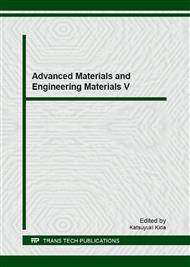p.256
p.261
p.267
p.273
p.278
p.284
p.290
p.297
p.301
Preparation and Characteristics of Highly Expandable Graphite Intercalation Compounds by Two-Step Chemical Intercalation
Abstract:
Graphite intercalation compounds (GIC) are the most common precursors for expanded graphites which are promising materials for many applications. A series of GICs with different expanding volumes (EV) were prepared by a two-step chemical intercalation way. Effects of the input of oxidant and intercalating agent on the EV of GICs were discussed. The microstructures and morphologies of graphites before and after intercalation were analylized by X-ray diffraction and scanning electron microscope, respectively. The results show that the GIC with an EV of 600 ml⋅g-1 may be prepared under temperal conditions by a two-step intercalation way. The interlayer spacing of the pre-GIC formeded by one-step intercalation is a bit larger than that of natural graphites, while the interlayer spacing of the GIC obtained by two-step intercalation becomes much larger than that of the pre-GIC because of secondery intercalation. When the d-spacing (d002) value of the GIC rises from 0.3590 nm up to 0.3711nm, its EV increases from 267 up to 600 ml⋅g-1 due to the decomposition and release of much more intercalated substances during a thermal shock.
Info:
Periodical:
Pages:
278-283
Citation:
Online since:
August 2016
Authors:
Price:
Сopyright:
© 2016 Trans Tech Publications Ltd. All Rights Reserved
Share:
Citation:


